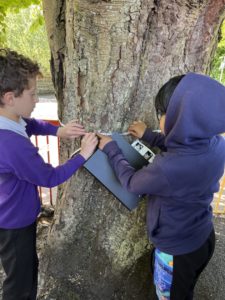Primary 6 were out in the school grounds last week, taking part in the OPAL Science Air Survey to try and find out about how polluted the air is in Pollokshields, as part of our Eco Schools work on the Climate Action topic.
There are two parts to this survey. One involves searching for particular types of Lichens growing on trees and the other part is about finding proof of Tar Spot fungus on Sycamore leaves. This starts to appear in late spring. Research suggests that the Tar Spot fungus does not thrive where pollution levels are high, so it could be a useful bioindicator. Biological indicators (or ‘bioindicators’) are species whose presence or performance is sensitive to changes in environmental conditions, and which can therefore be used as indicators of air quality.
The Lichen survey is concerned with pollutants containing nitrogen. These include
ammonia and oxides of nitrogen (nitric oxide and nitrogen dioxide). The burning of fossil fuels associated with industrial processes and transport produces large amounts of oxides of nitrogen and microscopic particles. Large urban areas and places close to busy roads have the highest concentrations of nitrogen dioxide. Lichens have long been known to be sensitive indicators of air quality. They were used in the past to map areas affected by sulphur dioxide pollution from industrial and domestic sources. Today, lichens occur widely in our towns, cities and countryside, on a diverse range of surfaces from concrete pavements to park and woodland trees. The highest ammonia concentrations are found in the countryside. Ammonia is particularly associated with agriculture. Levels of
ammonia may be high in areas of arable farming, where fertilisers are used to
improve the growth of crops, and in areas of livestock farming.
The pupils had to look for lichens at a height of 50-150cm above ground level. They had to grade and record the amount of lichens seen on a particular tree on a scale of 0-3 where 3 represents a large amount of lichen. They then used an identification guide , the Seek and iNaturalist apps to identify any species they found. You can see them in action in the photos below as well as the lichens that were spotted.
They examined a sample of 4 trees, and found evidence of crusty lichens only on three of them. These are not included in the survey. On one tree they found Parmelia. This is an intermediate species which can be found in both clean and polluted areas. We found no evidence of Tar Spot fungus in the survey. This was worrying as this has been seen in large amounts in our school grounds before and this could indicate an increase in air pollution around our school.
We would like to repeat the survey later in the year, using a different area of the grounds at the St. Andrew’s Drive side of our grounds to see if we can find any other bioindicator lichens to get a bigger picture of the state of air quality around our school.



